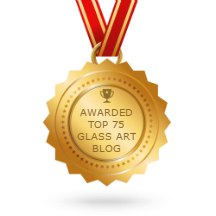I am in love with Ginkgo leaves and try to incorporate them wherever possible. Recently I discovered a good friend, Stacy, had a ginkgo tree near her house. She enlisted her sons, Jakob and Sean, to gather leaves for me and they found the best ones! Thank you, Jakob and Sean.
I also wanted to play more with Mica powder and so decided to combine the two. I have seen beautiful glass where someone takes a leaf and then puts Mica powder on the leaf and fires it. The leaf disintegrates at high temperature and leaves the Mica impression of the leaf behind. Let’s get started.
Try 1: Here is my process:
- To prepare the mica powder, mix a little of the powder with Glastac, a glass glue from Bullseye Glass. I don’t think Glastac is meant to be used as a paint medium, but it is what was in front of me and so worth a try.
- I am using three colors to try to add depth to each leaf. I had previously created a sample of fired mica powders, so from my sample piece I chose Red, Gold and Brown colors for the leaf colors.
- Paint your leaves with the mica powders. It is okay to mix the colors on the leaves, so I first painted one color and then added streaks of others on top.
- Now for the patience as we are going to let them sit over night so they completely dry.
- When they are dry, cut two 4.25″ square pieces of glass (one black, one clear).
- Place the black piece on the kiln shelf, place the leaves where you want them and then cap with the clear glass.
- At high temperatures, the leaves will disintegrate and leave a mica impression on the glass.
I decided to use a slow ramp (200 degrees) and a long bubble squeeze (2 hours) at 1100 to try to reduce the bubbles.
Okay, so how did it work? Try 1 produced a large bubble over each leaf which implies that there was still moisture. Argh. You could look at it and say cool, but I have read in several places that this bubble can be very thin and then the chards if it were to break would be very sharp. So better to not use this one.
Try 2: Maybe Glastic should be used for its intended purpose as a glue and I should use a paint medium. So after digging around because I thought I had bought some at some point, I found it and decided to try the paint medium. I didn’t change anything else as I want to see if the paint medium/glastic makes the difference between bubble and no bubble.
Results? Same as before. A nice big bubble over each leaf.
Try 3: So I know this works as I have seen it in finished pieces before. I scoured the net and learned first that it isn’t very common to do what I am doing because it doesn’t often work. But I am a glutton for punishment and I really wanted this to work. So my next try was to follow someone’s suggestion and at a slightly lower temperature on the ramp up, let the kiln sit at that temperature for a really long time so that the leaf itself will burn off. So I held it at 950 degrees F for 4 hours. Alas, same as before.
Try 4: I actually did all of the above in January and then not knowing what to do next, I just put all the failed pieces in a box and walked away from the project. And then the gestalt when I least expected it! Lying in bed one night and definitely not sleeping, it came to me. Instead of keeping the leaf in the fired piece, what if I could instead just transfer the image. After painting the leaf with the mica powder and then letting it dry for a few minutes, I then turned it over paint side down onto the black glass and rolled the back of the leaf with a rubber roller/brayer. I had to try this a few times to get it right, but after I was happy with the image, I let it dry. Later I capped it and fired, now using a normal firing schedule.
Voila! It worked!!!!!! I cannot tell you that this is the right way to do it. I can tell you this is the only way I could get it to work for me and I am a very happy experimenter right now. 🙂

All 4 Tries at Ginkgo Leaves and Mica Powder

Try 4 Close-up of Ginkgo Leaves and Mica Powder
NOTE: I discovered you can use either Glastac or Painters Medium – both work once I found the right way to do it.
Materials:
- Mica powder from a sample pack I bought from Arrow Springs at the Glass Craft and Bead Expo in Las Vegas. A great show!
- Glastac glue from Bullesye Glass
- Glass Painters Medium from Hotline
- Black and Clear glass from Bullseye Glass
- Rubber roller/brayer from ModPodge
Read Full Post »






